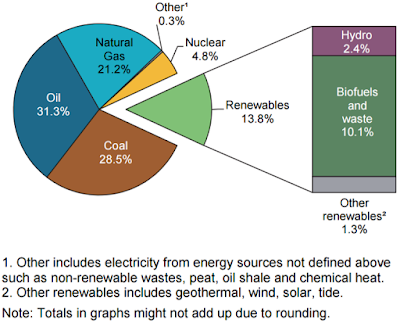Most, if not all, of the innovations and new ideas I'll be looking at will likely fail to make a big impact on the global energy scene. It's also very easy to get swept up in all the glitzy hype that some of these products have. But all it takes are a few key successes to accelerate the solar and renewable markets up to the heady heights of fossil fuels.
Note: I' not suggesting all these new ideas will change the world overnight, it will take many decades still. As you read this, think of changes happening on the timescale of massive global transformation.
Perovskite solar cells use materials that share a particular crystal structure known as, you guessed it, the
perovskite structure. Some perovskite materials act as semiconductors, and that is what makes them useful in solar cells. Current solar cells use silicon as the semiconductor - an expensive material of choice (and 2/3
of global supply comes from China). Perovskites on the other hand can be easily made in the lab. The
advantages don't just extend to cost however. The perovskite solar cells are a thin film - lightweight and transparent - and perovskites can be easily tuned to
different band gaps, to control the wavelength of light they absorb.
Olga Malinkiewicz, who founded Saul Technologies (the company from my earlier post), is
looking to develop cheap, flexible cells that can charge mobile devices and cover roof tiles. If they're a success, they could easily see use in powering the IoT and all our gadgets. This would make it easier for consumers to introduce solar technology to their homes. The sooner consumers begin to use and see the benefits of solar, the sooner solar and renewable technologies in general will be normalised and adopted on larger scales - and I really think that's an important point.
But Olga isn't the only person working on perovskite. The materials are a source of interest for
several companies and researchers who all see promise in their application; Oxford PV is one such example. They are creating
tandem solar cells, with perovskite being combined with other materials like silicon in the short term. The long term goal is durable
all-perovskite solar cells with complementary band gaps, keeping manufacturing costs and energy usage to a minimum. This could ultimately see perovskite solar cells being
incorporated into buildings, with normal glass being replaced with solar cells, helping to create self-sufficient buildings and potentially buildings generating surpluses of energy to feed into the grid.
There are of course hurdles that must be overcome, some of which are detailed
here. Perovskite solar cells are still not operating at the same efficiency as silicon solar cells, with a particular problem being size - perovskite solar cells are still typically very small and efficiency suffers when larger cells are produced. The crystals readily dissolve in water, questions still linger about their stability outside of lab conditions and some of the best perovskite solar cells so far have been made with lead, which is far from ideal.
What is encouraging however is the pace of development (see Figure 1). New records are being consistently achieved and hurdles overcome. In
July 2016 perovskite solar ce
lls over 1cm2 reached a maximum efficiency of 20.5%. Several months later,
a different team grew the largest perovskite solar cell crystal yet cre
ated at 16cm2 with an efficiency of 12.1%. have attempted to address the question of thermal stability with the introduction of carbon nanotubes. Further work by
Kim et al. (2016) has improved the stability of perovskite solar cells in humid environments, where water ingress poses the risk of dissolving the perovskite (and potentially any lead in the cells). They've achieved this by replacing the existing hole transfer layer used in perovskite solar cells with a hydrophobic, additive-free (the previous additive sucked in moisture) material that still has high hole mobility.
Attempts are being made to remove lead from the solar cells. Two teams have found ways to replace the lead but the resultant efficiencies have been very low (
5.7% and
6.4%). The hope is that lead-free perovskite cells will improve in efficiency at the same rate as leaded ones, which were about 6% efficient
only three years ago.
Alongside the technical achievements, I think it's important to highlight the financial backing perovskite solar cells have received. As well as just research grants, the cells are actively being prepared for market. Oxford PV, with the aim of 'commercialising technology from Oxford University', has recently
acquired a factory in order to begin developing market-ready manufacturing processes. Saule Technologies has also attracted considerable private investment. For perovskite solar cells to have attracted so much investment in such a short period of time is very promising for solar technology.
Revisit next week where I'll be looking further into the latest solar cell developments. I hope you all have a great Christmas!









